"Hiring mistakes are costly. Have you employed someone only to find they have disappointed you?" I’m sure we have all employed someone, only to find later that they weren’t what we thought they were, that they couldn’t do the job, or they didn’t fit in with the team. How can we avoid this happening in the future? Employing the wrong person can be costly. There’s the cost to terminate them and the cost to find and employ their replacement. But these costs could be minor compared to the damage that the wrong person can do to a project or company. We rely on our project managers and supervisors to deliver a quality project, safely, efficiently and on time. Failure can be expensive, costing the company money and reputation. In a few weeks huge damage can be done, but unfortunately, companies could take several months to act, to go through the termination process and find a replacement. A sad indictment is that sometimes companies don’t take action, and some of these poor-quality employees simply get transferred to other projects, where they continue to harm the company. Hiring new employees - where it goes wrongPeople are usually employed to replace someone who has left, or to fill a position on a new project. Unfortunately, these positions often have to be filled in a hurry, and construction companies, sometimes, have to make-do with literally the first (maybe only) candidate that walks through the door. Frequently the hiring process isn’t done properly, and we end up with a person unsuitable for the role, or someone who is unhappy and leaves. In some cases, somebody more senior and expensive than is required is employed. Often the main criteria for assessing the person are their skills and experience. However, construction companies and projects vary, and a suitable candidate for one project, or company, may not necessarily be the best for another. Sometimes the task of finding and employing someone is left entirely to the HR department, who are given only the briefest description of what’s required. “I need 5 Supervisors yesterday.” Regrettably, some companies base their hiring on whom they can afford. It’s not about the best candidate, rather about the cheapest. Construction is a people’s business. You can have the most expensive and best equipment, but if you don’t have the right people to operate and manage the equipment then it’s all for nothing. A good person can literally be worth their weight in gold. Of course just because a person earned a good salary with their previous employer doesn’t always mean they will be a good employee, or the right employee, for your project. "You can have the most expensive and best equipment, but if you don’t have the right people to operate and manage the equipment then it’s all for nothing." Who is the right person for your construction company?Here are 10 things that I think should be considered to determine if someone is the ‘right person’ to employ for your construction project or construction company.
"Look for people who take pride in their work." Of course you are probably unlikely to find the perfect candidate so you will probably have to compromise somewhere. Skills are probably easier to add to, but personalities can be hard to change. Remember to always do some background research. Don’t always believe what a candidate tells you, or that cv or piece of paper in front of you. Is there someone within your construction company?Before employing someone to fill a position it may be pertinent to consider the following:
Don't employ the wrong person for your construction project.Construction companies are always under pressure to cut costs and keep employee numbers to the minimum. This is often exacerbated by the cyclical nature of the construction business which can go from ‘boom’ to ‘bust’ almost overnight. Despite this, it makes sense for construction companies to have training programs to develop their employees to fill roles in the future. People will leave. Companies will obtain new construction projects. To always think that you will then, at short notice, be able to find just the ‘right person’ is short-sighted. In fact I’ve often seen that construction companies don’t find the ‘right person’. They end up employing the ‘wrong person’, which often leads to costly problems on the project, which even impacts the company’s reputation. Training and mentoring in construction What do you consider when you’re searching for someone to fill a roll? What experience have you had when the ‘wrong person’ was employed? This article was first published on the ClockShark website - Get The Industries' #1 Time-Tracking AppRunning a field service or construction business takes coordination and a great team. With ClockShark you get the industries' #1 timesheet app Please share this post Learn more about Construction Project ManagementTo read more about the author’s books and find out where you can purchase them visit the pages on this website by clicking the links below:
'Successful Construction Project Management: The Practical Guide' 'Building a Successful Construction Company: The Practical Guide' 'Construction Claims: A Short Guide for Contractors' 'Construction Project Management: Tips and Insights' 'Construction Book reviews' To read more about the author visit the page 'Paul Netscher' Want to contact Paul Netscher please enter your details on 'Contacts' Find out how Paul Netscher can help you Order your books from Amazon Order your books from Amazon UK © 2017 This article is not to be reproduced for commercial purposes without written permission from the author.
0 Comments
A lack of time is a problem for everyone working in construction. Most projects have an extremely tight construction schedule. Resources and skills are always in short supply. To succeed as a construction manager, you need to utilize time in the best way possible, so you can ensure a win-win situation both for you and your client. Being at the centre of the project, not only do you have to manage your own time, but often the time for the entire team working with you. That is why, time management skills are essential if you want to build a successful career as a construction manager. With that in mind, we did our research and below are some of the best time management practices for construction managers. These tips can help you to prioritize the tasks and make sure that you and your team deliver the project efficiently. 1. Build the project baseline before you start This is the first step in measuring the project success and preparing an efficient time management strategy. By investing extra attention at this early stage of the project, you can feel more secure of the outcome of your efforts. It is here that the work breakdown structure, the project scope, and project phases are determined based on a detailed time-frame. The project manager needs, at this point, to examine if the set deadlines are appropriate and realistic. This can help detect potential challenges and obstacles that could be experienced in the course of the project. If appropriate measures are put in place early enough delays can be prevented. This progress against the schedule should be checked and updated weekly or biweekly. Slippage should be addressed and corrective actions taken. 2. Assign the project resources efficiently It’s no secret that, the success of a project depends on the team. You need to understand your team well, learn their skills, and the workloads they can handle comfortably in a single day. In that manner, you can be sure that the various construction agents will be able to complete their tasks within the set timeframe, since they know what they are doing. If the allocation is done poorly without any skills assessment, there is a likelihood of time mismanagement, missed milestones, and overstretching of the set budgets. Equip your teams appropriately to ensure resources are utilized effectively with set goals achieved at the close of business. 3. Use a task and project scheduling tool A timeline outlining the work sequence from beginning to completion is important in any project schedule. Creating a project schedule is challenging due to the unknown variables that may emerge along the way. It goes without saying that you can’t predict everything, but a properly resourced schedule can be an essential element in time management and project planning. You can identify the real-time completion, determine the workloads at different phases and the estimated budgets. Project scheduling and task software help you share important details with the client, the team, and partners. Everyone knows what has to be done and by when, using the allocate resources for the task. 4. Take further training to boost your management skills With increased workloads as a site manager, smart time management remains one of your main focus points. That is why, you constantly need to become better and boost your skills so you can increase your efficiency. Construction is a rapidly evolving field and you need to stay up to date with the latest information on various practices and methods. You need to possess knowledge in many different fields such as time tracking, scheduling and resource planning. On top of that, you should invest on the training of your team members, as well. By doing that, you can feel safe that your team is working as it should even when you aren’t around. 5. Find a solid project management software In recent times, tracking several aspects of a project in real-time and capturing the correct information has proved to be difficult. Carrying out all these tasks manually can be hectic and take much of your time, while there’s always of inaccurate calculations providing the incorrect information. Large projects often add complexity and more participants in the team. The right construction management software can help. Some of the main features that you want to look for are real-time collaboration, unlimited accessibility and secure cloud hosting. All in all, construction software can be a valuable tool in your hands. Conclusion From the above, it is evident that project success is greatly depended on good time management. Always aim to accomplish more while making the minimum effort possible. Take advantage of the latest technological innovations to increase the chances of you succeeding at every project you are in charge of. Having more time enhances your creativity that most clients look for beyond your skills. This is a guest blog written by Anastasios Koutsogiannis from GenieBelt. The new news is fabricated news! What news are you using on your project? "There are three kinds of lies: lies, damned lies, and statistics." "Figures often beguile me, particularly when I have the arranging of them myself” Mark Twain. All too often we selectively choose the facts and information we like, then weave them into a story that suits us, one we want to believe. News and facts that don’t match our ideals and beliefs are discarded. Over the last few months much has been made of the false news stories and statements that have proliferated on Facebook, Twitter and other forms of social media. These ‘facts’ and ‘statements’ are taken as the truth, and hungrily consumed by those who want to believe them. In fact, recently we have been introduced to a new term - ‘alternative facts’! Of course, there is nothing new about this and it has been happening through the centuries. We certainly don’t have to look too far into the history books. In fact, many of the wars and political purges in the past have been justified by misinformation. News is regularly distorted, or bent, to show a particular view. It’s also easy to ignore the news we don’t want to believe or hear – for many it’s as easy as changing the news channel, or buying another newspaper, or, in the case of Facebook and even website search engines you’ll be sent similar articles to the ones you read and liked, or be provided with web pages similar to the ones you regularly access. So, very quickly we can be surrounded by news stories and content we like and believe, to the detriment of other views which could provide counter arguments and a more rounded view of the World. But hey, who wants to hear things we don’t like, or that we disagree with, when we can selectively view the ‘good’ stories? After all, when we were kids we were allowed to believe in happy fantasies such as Father Christmas, the Tooth Fairy and other fairy tales where everyone lived happily ever after – except the bad guys! Regrettably, on many construction projects the truth is hidden from view until the end when the project falls apart – completed late, with massive losses and often acrimony and blame between the contracting parties. Indeed, a few years back a construction company in West Australia that appeared to be performing well and had many years of successful growth and profits suddenly reported losses of $600 million. How was it possible for a company, in only a few months, to turn a profit into such a huge loss – especially when these losses were primarily the result of two projects that had been under construction for several years and were now reaching completion? These losses didn’t occur overnight – they occurred over several years. In this day and age, when we have so many project management resources, how is it possible that the truth about a project’s performance can stay hidden from view until the end? Well, this can be for a number of reasons which includes:
So let’s consider some of the reporting systems on our projects and see where they go wrong. The Project Schedule I’m sure we have all witnessed projects that have appeared to be tracking on schedule and then near the end things fell apart? Project schedules are essential to any project and I would never attempt a project without one. Yet, even with the best schedule it’s possible to report the project as being on schedule even when it’s not. Many project managers have succeeded in manipulating schedules to show management and the client that they are on schedule (even when they aren’t) and will complete the project on time. However, in some cases even the project manager is caught unawares when the project is completed late. There are many reasons for this which includes:
The Project cost report Most projects produce a monthly cost report. Unfortunately these often aren’t correct which could be because:
A project can appear to be safe, but in fact a major accident could be waiting to happen. Just because a project hasn’t had a serious accident doesn’t mean that the project is safe. Sometimes projects survive by luck, which unfortunately seldom lasts until the end. Some projects ignore minor accidents and they aren’t reported – they are treated as being too much paperwork and trouble. It has been proven that many small incidents will ultimately lead to more serious incidents. Even minor safety transgressions that aren’t dealt with can lead to more serious violations which ultimately leads to a serious accident. It’s essential to take corrective actions early to prevent a serious accident. Quality Frequently quality problems are ignored during construction. Either the project team doesn’t understand what good quality is, they don’t care, or they avoid looking for problems. When problems are detected we hear excuses, or that the problem will be fixed at the end, or that the client won’t notice. Let’s ignore the problem, or tell ourselves that it’s not as bad as some make it out to be! No wonder some contractors are surprised at the end of the project when they take several months to complete snag lists (punch lists) consisting of thousands of items. Quality systems should provide the checks to ensure that work is done correctly, and they should provide information of what faults have been detected. Importantly, the team should understand what the quality requirements are for the project and substandard work shouldn’t be tolerated. Conclusion You can have your own opinions but not your own facts. Good project systems are essential to monitor the health of your project. But these systems must be used and interpreted correctly. We cannot choose what news we want to hear and which news we will turn off. We need to know when our project is going badly – even if we don’t want to know. Our managers need to be informed when there are problems – even if they don’t want to know. Knowing there is a problem it is equally important to understand the cause, and then to take the correct actions to rectify the problem. If the problem can’t be fixed – maybe the project will be late or it will lose money – then those that need to be informed must be told as soon as possible so that they can make alternative arrangements. We cannot ignore bad news. We cannot ignore the news we don’t want to hear. But equally important is to check the source of your project news – is it reliable and is it backed by sound logic and facts. Are you ignoring bad news on your project? Are your sources of information reliable and are you interpreting them correctly? This article is adapted from information in the author’s popular books: 'Successful Construction Project Management: The Practical Guide' and 'Building a Successful Construction Company: The Practical Guide' and 'Construction Project Management: Tips and Insights'
'Construction Claims: A Short Guide for Contractors' is another of Paul's useful books. These books are available on Amazon and other online book stores. Paul publishes articles regularly on LinkedIn and his website. Paul writes regular articles for other websites, gives lectures, mentors, and is available for podcasts and interviews. © 2017 This article is not to be reproduced for commercial purposes without written permission from the author. Efficiency eludes the construction industry
Read this interesting article 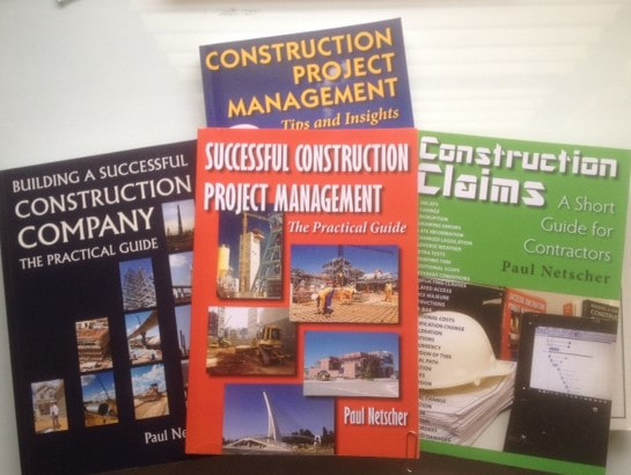 I really appreciate the good reviews that readers have taken the time to post on Amazon and other websites. It’s always nice to have positive feedback of my books from readers. Recently I received 3 five star reviews for ‘Construction Claims: A Short Guide for Contractors’. 2 on Amazon.com and 1 on Amazon UK. One reader said: “An excellent, concise and very practical guide to successful claims process. This is a no nonsense approach that gets on with it.” ‘Successful Construction Project Management: The Practical Guide’ has received great reviews on Amazon.com, Amazon UK, Amazon Australia, Amazon Canada, Amazon Spain and on Goodreads. One reader said: “Very useful, easy to read and informative.” Another said: “Really good read. The book gives basic overview of key skills and strategies needed to run a construction site effectively. Would recommend it to any young aspirant contractors.” ‘Building a Successful Construction Company: The Practical Guide’ has been given 8 good reviews on Amazon.com. One reader said: “A practical guide based on great experience of a real professional.” It’s amazing how we share similar problems in construction no matter where we are, and that my construction books can be read and appreciated in so many countries. Readers have taught me how important it is to write positive reviews. Once again thank you for reading my books and writing such great reviews. If you bought one of my books and found it useful please post a review on the website where you purchased it. All books are available from Amazon and other online stores in paper and ebook. Get your copy now. 'Successful Construction Project Management: The Practical Guide' and 'Building a Successful Construction Company: The Practical Guide' and 'Construction Project Management: Tips and Insights' and 'Construction Claims: A Short Guide for Contractors' Will your client contribute to your construction projects success, or to its failure? Regrettably, sometimes projects end badly. They are of poor quality, aren’t fit for purpose, they are completed late, they end over budget, have people injured or killed during construction, or they do not deliver value for money. When construction projects go wrong contractors are usually blamed. If they can’t be found responsible, then the problem must be a result of the designers’ actions. Unfortunately, often the problem is a result of the client, or customer’s, actions – or lack of actions. Clients have certain responsibilities, and some of these start long before the construction process begins. It’s important that contractors ensure that their clients fulfill these obligations, because failures could be devastating for the project, and possibly for the contractor. The client’s obligations The client should ensure that they are constructing the best project, in the right place, at the right time which will provide the required outcomes they desire. There are many ‘white elephants’ in the world, projects that are built for the wrong reasons, possibly in the wrong place, or a project that is clearly unsuitable. Clients need to properly research their projects before starting work to ensure the project will be the optimal project that will yield the best value and result. But even when the client has chosen the most suitable project in the optimal location they have many responsibilities that they need to comply with to ensure the contractor can carry out the project works (some of these may be outlined within the contract documents). The client’s responsibilities include, amongst others:
This article was first published on the ClockShark website. To visit this website and continue reading the article click on the link above.
Please share this post To read more about the author’s books and find out where you can purchase them visit the pages on this website by clicking the links below: 'Successful Construction Project Management: The Practical Guide' 'Building a Successful Construction Company: The Practical Guide' 'Construction Claims: A Short Guide for Contractors' 'Construction Project Management: Tips and Insights' 'Construction Book reviews' To read more about the author visit the page 'Paul Netscher' Want to contact Paul Netscher please enter your details on 'Contacts' Find out how Paul Netscher can help you Order your books from Amazon Order your books from Amazon UK © 2017 This article is not to be reproduced for commercial purposes without written permission from the author. |
Archives
June 2024
Note: We welcome genuine comments, especially comments that add additional information to the subject matter in the article. We however reserve the right to remove inappropriate comments, which includes comments that have nothing to do with the subject, comments that include inappropriate language, and comments that are an advertisement for a product or company, or which include an advertising link. Comments must be in English. We will not enter into discussion on why a particular comment was removed.
CategoriesCopyright 2016 - The attached articles cannot be reproduced for commercial purposes without the consent of the author.
The opinions expressed in the attached articles are those of the writer. It should be noted that projects are varied and different laws and restrictions apply which depend on the location of the contractor and the project. It's important that the reader uses the supplied information taking cognisance of their particular circumstances. The writer assumes no responsibility or liability for any loss of any kind arising from the reader using the information or advice contained herein. "I have what I consider some of the best books on construction management."
Books are available from: Amazon.com Amazon.co.uk takealot.com kalahari.com Amazon.in Amazon.de Amazon.fr Amazon.it Amazon.com.au Powell's Fishpond uread bokus Amazon.ca Amazon.es Other retail stores Available in paperback or on Kindle "28 YEARS OF CONSTRUCTION PROJECT MANAGEMENT EXPERIENCE, DEVELOPING SUCCESSFUL CONSTRUCTION PROJECT MANAGERS AND BUILDING SUCCESSFUL CONSTRUCTION COMPANIES"
|


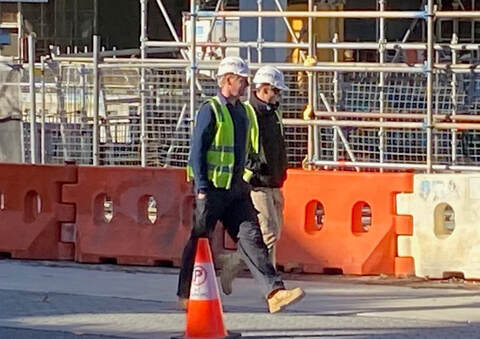
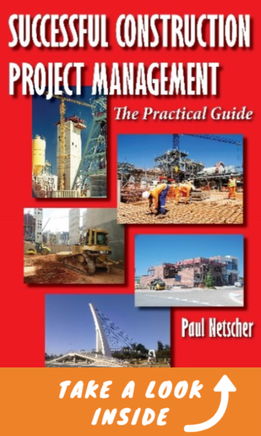
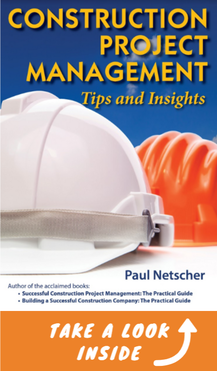
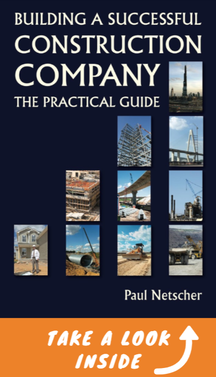
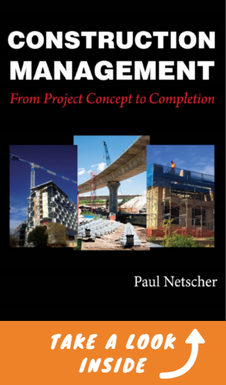




 RSS Feed
RSS Feed




